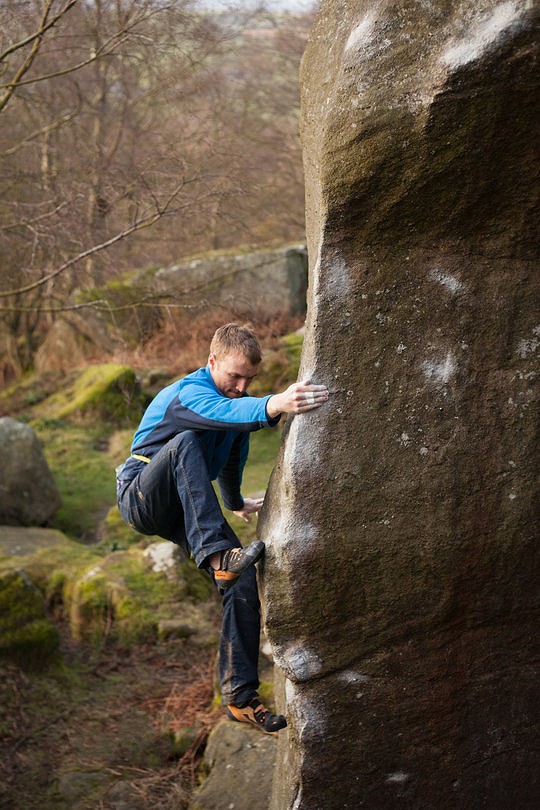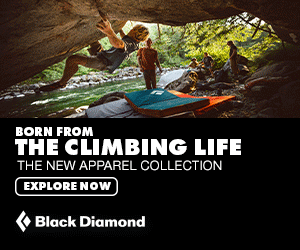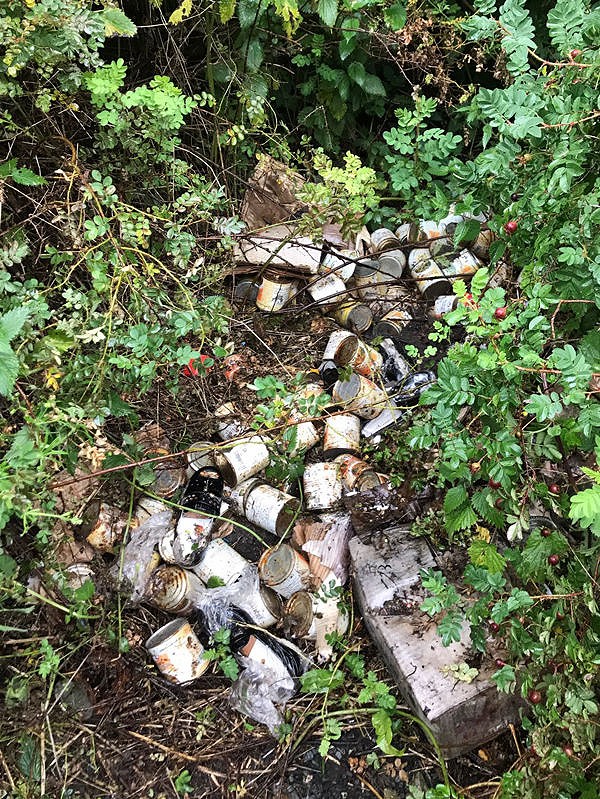The Countryside Code
From a young age we're all told to 'follow the countryside code'; however I am sure that a great many of us don't actually know what the code itself is. If we uphold a basic level of respect for the environment and the people within it we don't necessarily need to either; but recent events - including the sad story of Whitehouses - call for a quick reminder as to exactly what the code entails.

Consider the local community and other people enjoying the outdoors
The first step to generating good will within a local community is to park considerately when visiting a crag. The exact spot to park should be outlined in the relevant guidebook or app, but it's also worth keeping an eye on the BMC RAD (Regional Access Database) for any updates that may have taken place since the guide's publication.
If parking on a country lane, avoid parking in front of gates and remember to leave enough room for other vehicles to pass (including tractors/trailers, delivery lorries, emergency services etc). Whilst a somewhat extreme example, the events that took place at Seathwaite last summer are an illustration of rather extraordinary retribution if this rule is disobeyed, but another consequence could be a revoking of access to the crag itself. Kilnsey, as referenced within the last #respecttherock article, is a good example of where this eventuality could occur if bad practise continues.
Another poignant example of this is over at Bovey Woods in Devon, where access is best described as sensitive. Whilst it's unclear whether or not climbers are to blame for the parking in the photograph below, climbers are liable to get the blame due to their being in the spotlight. In order to combat this I suggest we do as the individual who spotted this did and upload the photographs onto social media afterwards. This was subsequently shared by both Dartmoor Bouldering and javu, two local information services for climbers in the South West. This sort of proactivity tends to be noticed by landowners (particularly larger landowners such as the National Trust), hence it reflects very well on climbers making an effort in the right direction. As per the advice within the last article in the series, if you see the individual or group involved in such bad practise, try - if you can - to have a polite word. The tone of approach is key here, and there is no denying it can lead to an awkward interaction, however real-time interaction is far more likley to have a real effect than posting online afterwards. Part of the problem we face is reaching these people, so seize the moment if you can!
If parking in a more urban environment, be conscious of residential parking areas. I'm sure most of us have experienced the intricacies of local parking arrangements (aka. parking politics) at one point in our lives and whilst we would all wish to rise above them, some locals may not. As such use car parks (if appropriate/available) or park a little further away and walk. If it leads to more harmonious crag access then you'll have done a good turn.
In the event of a car parking area being full you have a handful of options. The first is to try and park further away (as suggested above) and the second is to simply climb elsewhere. Whilst we all wish to climb our project at all costs, access is of the utmost importance and sometimes it's worth knowing when to leave it for another day in favour of the greater good.
One final point comes hand in hand with parking, usually after a long drive, and that is the matter of nature calling. In a more natural environment you may be fine, but in a more inhabited spot this may not be entirely appropriate (read: it's massively inappropriate). A few years back, parking behind the Cove Centre at Malham was lost because of climbers doing exactly this. A recent example shared on social media was someone - almost certainly a climber - taking a crap in the driveway to a family home at the parking spot for Beinn Udlaidh. As a general rule of thumb: people don't like other people pissing in their garden. The only thing people like less is other people shitting in their garden, which is exactly why we no longer have access to Eagle Tor (and that's not even a joke...).
Another way of annoying virtually everyone from locals to landowners, climbers to hillwalkers, to pretty much any other member of the human race, is to be loud. This could be verbally through shouting or through the playing of music. In short, the playing of music at crags is NEVER acceptable. If you start to crank up the boom box…or in this more modern day and age a bluetooth speaker…stop and consider what you're doing. Music tastes vary and by playing it out loud you are basically inflicting your own opinions on everyone else in the area, a wildly selfish act. You might arguably place inconsiderate drone use in the same category too, as it is once again the noise of the individual having an impact on the enjoyment of the many.
Leave gates and property as you find them and follow paths unless wider access is available
If there's a prime way to piss off a farm it's to leave gates open or jump over walls. As such, don't do it - even if they're not looking (they've got eyes in the back of their heads anyway). Like many aspects of this article, this may seem obvious, but the following case study indicates that is it actually might not be to some people:
In an effort to improve access relations with the landowner the BMC decided to get a sign made to go alongside the parking at Almscliffe, outlining the approach, the fact lamp sessions aren't allowed, plus a few other facts for folk to read up on (should they be interested).
It did the trick, the local farmer was happy, but a few weeks later made a somewhat unorthodox discovery when he found a group of people (some climbers, some non-climbers) approaching the crag along the top of the dry-stone wall (yes, you read that right). Why? The mind boggles, but I'd assume it was so that the individuals in question wouldn't get their feet muddy on the actual path that runs alongside the wall.
This isn't an isolated event either, with more reports coming in each week. Again, it only takes a small number of people to have a negative impact on acccess, so if you do see people behaving this way don't be afraid to highlight that they are in the wrong!
Leave no trace of your visit and take your litter home
I've always thought that climbers are actually quite good at cleaning up their own rubbish. Having participated in the Outside Crag Clean Up for the past few years, it became obvious that our crags - at least in and around the Peak District - are by and large very tidy places. It's the car parks which are often worse. Regular highlights include anything from cans of Coca Cola, Monster, Strongbow and Stella to unsavoury personal items... And dog walkers - can anyone tell me what (if anything) goes through the mind of anyone who hangs bags full of shit in trees for the poo fairies to clean up?
Before and After at the 2017 Outside Crag Clean Up
That said, we're not entirely innocent, as old finger tape, fruit peel, fag buts and the occasional sodden chalk ball are found from time to time. With that in mind, if you see it - pick it up. Popping a spare plastic bag in the top of your pack which you can fill with some of the odds and sods will guarantee you get your good scout award. If you get the time, maybe join in on a clean-up even such as WiltonFest, TremFest, or the Outside Crag Clean Up.
Beyond litter, 'leave no trace' also extends to the issues discussed regarding chalk use within the first article of the series. Loads of white/chalky rock is pretty weird, so try and leave it in the best condition possible. On a more serious note there is a the matter of chipping, which is very much a no-no within the modern world of climbing. Whilst you don't hear of it happening a great deal, Theo Moore - Advertising Manager here at UKClimbing - witnessed something that was tantamount to chipping whilst he was at Brimham Rocks late last year:
Brimham Rocks has for a long time been popular with boulderers due to its excellent problems in a range of grades and easy access.
When I visited before Christmas, the Car Park boulders - arguably the most popular area of the crag - were heaving, so as I looked around for somewhere to climb I noticed an oddly-placed assortment of Brie and a wine bottle in the break of Pommel. Weird. Anyway, I managed to find something suitable to warm-up on and before long heard music playing around the corner. I wanted to do a problem over there so I wandered over to have a look. A large group of climbers were climbing in an area not just used by climbers, but by countless walkers too. They were blasting out music and drinking wine and beer (it wasn't even midday!). I was annoyed, but not particularly surprised. What did surprise me though was that, when climbing a problem next to them, one of the party stepped forward about to smash open the top of their beer on a hold. I stopped them immediately, told the individual it was a bad idea, and that the damage would be irreparable to which they replied "it's more likely to break the bottle" but thankfully gave up.
I went about the rest of my session knowing I'd averted a disaster, then just before I left I noticed "I LOVE COCK" written in chalk just beside the crag classic Pommel. I gave it a good brushing but it didn't do a lot.
What a day…

For those that haven't been, Brimham's rock is actually at the softer end of the Gritstone spectrum and is exceptionally sandy in places. As such, had the individual in question broken their bottle top off on the hold there's a reasonable chance of the hold having come off with it. This story - despite its somewhat sobering ending - at least demonstrates that having a polite word there and then can make a difference, so please do.
Plan ahead and be prepared
I think this aspect of the Countryside Code is mostly geared towards the unprepared masses marching to their doom on Snowdon, Scafell, and the suchlike, but it has other applications to climbers.
There's only one thing worse than failing on your project: it's destroying your project!
When it comes to weather, certain rock types (e.g. sandstone, gritstone) are easily damaged when wet. As a result, you need to be aware not just of the forecast for the days ahead, but also of what it's been doing for the past few days as well. Thankfully the UKC Logbooks record this, so if you are going to somewhere sensitive it's worthwhile taking a quick look to ensure you're not going to do lasting damage.

Aside from weather there's always access to be considered. The initial reference point for access tends to be through the guidebook, where it will tell you how to get there, where to park, and how to go about the approach; however, information can change over time, so I would highly recommend using the BMC's live update system - the BMC's Regional Access Database (aka. the RAD). This is available in App form (Android here, iOS here), on the BMC's website, and also via the UKC Logbooks.
Probably the most frequently found reason for a lack of access is bird nesting, with a relatively sizable number of crags being out of bounds between around 1st Feb - 1st August due to nesting Peregrines, Ravens, Ring Ouzels, and Choughs (just to name a few). Whatever the rights and wrongs of commercial shooting (and let's face it, poor countryside management has a worse environmental impact than we climbers ever could), for the purposes of continued friction-free access if nothing else, it is worth respecting the fact that grouse moors tend to have their out of bounds seasons, while the deer stalking season in Scotland has a similar bearing on where it might be responsible to try to climb on a given day.
As a few examples of other quirks I've come to enjoy, there are certain crags in Northumberland (such as Queens Crag, Callerhues, and the Dovehole Boulders) that require you to inform the farmer of your interest to climb at the crag first, that way they're aware you're on there land (and not some poachers). It may seem strange at first, but I've had nothing but good interactions with each and every farmer I've spoken to whilst climbing in the County, and it's a great way to foster good relations.
Follow advice and local signs
Occasionally you'll get to a crag and things will have changed. A recent example of this happening is at Kyloe in the Woods, where there have been unplanned closures due to hunting taking place. Thankfully, thanks to the combined efforts of BMC Access Officer Rob Dyer and local volunteer Franco Cookson things have swung massively in our favour, with the land manager for Scottish Woodland permitting access to the cag at any time, regardles of whether stalking is taking place, providing we stick to the main path at all times. We owe both individuals a word of thanks which can be duly shown by following the rules.
Remember that if you see a sign to go elsewhere, whilst you may have come a long way, and no matter if you really want to climb your project, long-term good relations between landowners and the climbing community trump such short term needs any day.








